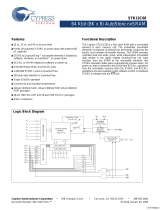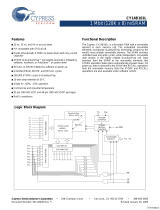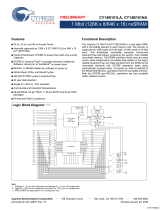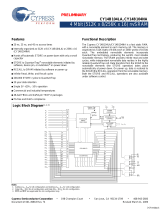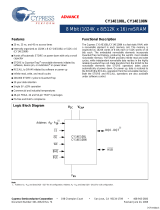Page is loading ...

STK16C88-3
256 Kbit (32K x 8) AutoStore+ nvSRAM
Cypress Semiconductor Corporation • 198 Champion Court • San Jose
,
CA 95134-1709 • 408-943-2600
Document Number: 001-50594 Rev. ** Revised January 29, 2009
Features
■
Fast 35ns Read access and R/W cycle time
■
Directly replaces battery-backed SRAM modules such as
Dallas/Maxim DS1230W
■
Automatic nonvolatile STORE on power loss
■
Nonvolatile STORE under Software control
■
Automatic RECALL to SRAM on power up
■
Unlimited Read/Write endurance
■
1,000,000 STORE cycles
■
100 year data retention
■
Single 3.3V+0.3V power supply
■
Commercial and Industrial Temperatures
■
28-pin (600 mil) PDIP package
■
RoHS compliance
Functional Description
The Cypress STK16C88-3 is a 256Kb fast static RAM with a
nonvolatile element in each memory cell. The embedded
nonvolatile elements incorporate QuantumTrap
™
technology
producing the world’s most reliable nonvolatile memory. The
SRAM provides unlimited read and write cycles, while
independent, nonvolatile data resides in the highly reliable
QuantumTrap cell. Data transfers from the SRAM to the
nonvolatile elements (the STORE operation) takes place
automatically at power down. On power up, data is restored to
the SRAM (the RECALL operation) from the nonvolatile
memory. Both the STORE and RECALL operations are also
available under software control.
Logic Block Diagram
[+] Feedback

STK16C88-3
Document Number: 001-50594 Rev. ** Page 2 of 14
Pin Configurations
Figure 1. Pin Diagram - 28-Pin PDIP
Table 1. Pin Definitions - 28-Pin PDIP
Pin Name Alt IO Type Description
A
0
–A
14
Input Address Inputs. Used to select one of the 32,768 bytes of the nvSRAM.
DQ
0
-DQ
7
Input or
Output
Bidirectional Data IO lines. Used as input or output lines depending on operation.
WE W
Input Write Enable Input, Active LOW. When the chip is enabled and WE is LOW, data on the
IO pins is written to the specific address location.
CE
E
Input Chip Enable Input, Active LOW. When LOW, selects the chip. When HIGH, deselects the
chip.
OE
G
Input Output Enable, Active LOW. The active LOW OE input enables the data output buffers
during read cycles. Deasserting OE
HIGH causes the IO pins to tri-state.
V
SS
Ground Ground for the Device. The device is connected to ground of the system.
V
CC
Power Supply Power Supply Inputs to the Device.
$
$
$
$
'4
'4
'4
$
$
$
$
$
$
$
$
'4
'4
9
66
$
&(
$
$
9
&&
:(
'4
'4
'4
2(
723
[+] Feedback

STK16C88-3
Document Number: 001-50594 Rev. ** Page 3 of 14
Device Operation
The AutoStore+ STK16C88-3 is a fast 32K x 8 SRAM that does
not lose its data on power down. The data is preserved in integral
QuantumTrap non-volatile storage elements when power is lost.
Automatic STORE on power down and automatic RECALL on
power up guarantee data integrity without the use of batteries.
SRAM Read
The STK16C88-3 performs a READ cycle whenever CE and OE
are LOW while WE is HIGH. The address specified on pins A
0–14
determines the 32,768 data bytes accessed. When the READ is
initiated by an address transition, the outputs are valid after a
delay of t
AA
(READ cycle 1). If the READ is initiated by CE or OE,
the outputs are valid at t
ACE
or at t
DOE
, whichever is later (READ
cycle 2). The data outputs repeatedly respond to address
changes within the t
AA
access time without the need for transi-
tions on any control input pins, and remains valid until another
address change or until CE
or OE is brought HIGH.
SRAM Write
A WRITE cycle is performed whenever CE and WE are LOW.
The address inputs must be stable prior to entering the WRITE
cycle and must remain stable until either CE or WE goes HIGH
at the end of the cycle. The data on the common IO pins DQ
0–7
are written into the memory if it has valid t
SD
, before the end of
a WE
controlled WRITE or before the end of an CE controlled
WRITE. Keep OE
HIGH during the entire WRITE cycle to avoid
data bus contention on common IO lines. If OE
is left LOW,
internal circuitry turns off the output buffers t
HZWE
after WE goes
LOW.
AutoStore+ Operation
The STK16C88-3’s automatic STORE on power down is com-
pletely transparent to the system. The STORE initiation takes
less than 500 ns when power is lost (V
CC
<V
SWITCH
) at which point
the part depends only on its internal capacitor for STORE com-
pletion.
If the power supply drops faster than 20 μs/volt before Vcc
reaches Vswitch, then a 2.2 ohm resistor should be inserted
between Vcc and the system supply to avoid a momentary
excess of current between Vcc and internal capacitor.
In order to prevent unneeded STORE operations, automatic
STOREs are ignored unless at least one WRITE operation has
taken place since the most recent STORE or RECALL cycle.
Software initiated STORE cycles are performed regardless of
whether or not a WRITE operation has taken place.
Hardware RECALL (Power Up)
During power up or after any low power condition (V
CC
<V
RESET
),
an internal RECALL request is latched. When V
CC
once again
exceeds the sense voltage of V
SWITCH
, a RECALL cycle is
automatically initiated and takes t
HRECALL
to complete.
If the STK16C88-3 is in a WRITE
state at the end of power up
RECALL, the SRAM
data is corrupted. To help avoid this
situation, a 10 Kohm resistor is connected either between WE
and system V
CC
or between CE and system V
CC
.
Software STORE
Data is transferred from the SRAM to the nonvolatile memory by
a software address sequence. The STK16C88-3 software
STORE cycle is initiated by executing sequential CE controlled
READ cycles from six specific address locations in exact order.
During the STORE cycle, an erase of the previous nonvolatile
data is first performed followed by a program of the nonvolatile
elements. When a STORE cycle is initiated, input and output are
disabled until the cycle is completed.
Because a sequence of READs from specific addresses is used
for STORE initiation, it is important that no other READ or WRITE
accesses intervene in the sequence. If they intervene, the
sequence is aborted and no STORE or RECALL takes place.
To initiate the software STORE cycle, the following READ
sequence is performed:
1. Read address 0x0E38, Valid READ
2. Read address 0x31C7, Valid READ
3. Read address 0x03E0, Valid READ
4. Read address 0x3C1F, Valid READ
5. Read address 0x303F, Valid READ
6. Read address 0x0FC0, Initiate STORE cycle
The software sequence is clocked with CE
controlled READs.
When the sixth address in the sequence is entered, the STORE
cycle commences and the chip is disabled. It is important that
READ cycles and not WRITE cycles are used in the sequence.
It is not necessary that OE
is LOW for a valid sequence. After the
t
STORE
cycle time is fulfilled, the SRAM is again activated for
READ and WRITE operation.
Software RECALL
Data is transferred from the nonvolatile memory to the SRAM by
a software address sequence. A software RECALL cycle is
initiated with a sequence of READ operations in a manner similar
to the software STORE initiation. To initiate the RECALL cycle,
the following sequence of CE
controlled READ operations is
performed:
1. Read address 0x0E38, Valid READ
2. Read address 0x31C7, Valid READ
3. Read address 0x03E0, Valid READ
4. Read address 0x3C1F, Valid READ
5. Read address 0x303F, Valid READ
6. Read address 0x0C63, Initiate RECALL cycle
Internally, RECALL is a two step procedure. First, the SRAM data
is cleared, and then the nonvolatile information is transferred into
the SRAM cells. After the t
RECALL
cycle time, the SRAM is once
again ready for READ and WRITE operations. The RECALL
operation does not alter the data in the nonvolatile elements. The
nonvolatile data can be recalled an unlimited number of times.
[+] Feedback

STK16C88-3
Document Number: 001-50594 Rev. ** Page 4 of 14
Hardware Protect
The STK16C88-3 offers hardware protection against
inadvertent STORE operation and SRAM WRITEs during low
voltage conditions. When V
CAP
<V
SWITCH
, all externally
initiated STORE operations and SRAM WRITEs are inhibited.
Noise Considerations
The STK16C88-3 is a high speed memory. It must have a high
frequency bypass capacitor of approximately 0.1 µF
connected between V
CC
and V
SS,
using leads and traces that
are as short as possible. As with all high speed CMOS ICs,
careful routing of power, ground, and signals helps prevent
noise problems.
Low Average Active Power
CMOS technology provides the STK16C88-3 the benefit of
drawing significantly less current when it is cycled at times
longer than 50 ns. Figure 2 and Figure 3 shows the
relationship between I
CC
and READ or WRITE cycle time.
Worst case current consumption is shown for both CMOS and
TTL input levels (commercial temperature range, VCC = 5.5V,
100% duty cycle on chip enable). Only standby current is
drawn when the chip is disabled. The overall average current
drawn by the STK16C88-3 depends on the following items:
1. The duty cycle of chip enable
2. The overall cycle rate for accesses
3. The ratio of READs to WRITEs
4. CMOS versus TTL input levels
5. The operating temperature
6. The V
CC
level
7. IO loading
Figure 3. Current Versus Cycle Time (WRITE)
Best Practices
nvSRAM products have been used effectively for over 15
years. While ease-of-use is one of the product’s main system
values, experience gained working with hundreds of applica-
tions has resulted in the following suggestions as best
practices:
■
The nonvolatile cells in an nvSRAM are programmed on the
test floor during final test and quality assurance. Incoming
inspection routines at customer or contract manufacturer’s
sites will sometimes reprogram these values. Final NV
patterns are typically repeating patterns of AA, 55, 00, FF,
A5, or 5A. End product’s firmware should not assume a NV
array is in a set programmed state. Routines that check
memory content values to determine first time system config-
uration and cold or warm boot status, should always program
a unique NV pattern (for example, complex 4-byte pattern of
46 E6 49 53 hex or more random bytes) as part of the final
system manufacturing test to ensure these system routines
work consistently.
■
Power up boot firmware routines should rewrite the nvSRAM
into the desired state. While the nvSRAM is shipped in a
preset state, best practice is to again rewrite the nvSRAM
into the desired state as a safeguard against events that
might flip the bit inadvertently (program bugs or incoming
inspection routines).
Figure 2. Current Versus Cycle Time (READ)
[+] Feedback

STK16C88-3
Document Number: 001-50594 Rev. ** Page 5 of 14
Table 2. Software STORE/RECALL Mode Selection
CE WE
A
13
– A
0
Mode IO Notes
L H 0x0E38
0x31C7
0x03E0
0x3C1F
0x303F
0x0FC0
Read SRAM
Read SRAM
Read SRAM
Read SRAM
Read SRAM
Nonvolatile STORE
Output Data
Output Data
Output Data
Output Data
Output Data
Output Data
[1, 2]
L H 0x0E38
0x31C7
0x03E0
0x3C1F
0x303F
0x0C63
Read SRAM
Read SRAM
Read SRAM
Read SRAM
Read SRAM
Nonvolatile RECALL
Output Data
Output Data
Output Data
Output Data
Output Data
Output Data
[1, 2]
Notes
1. The six consecutive addresses must be in the order listed. WE
must be high during all six consecutive CE controlled cycles to enable a nonvolatile cycle.
2. While there are 15 addresses on the STK16C88-3, only the lower 14 are used to control software modes.
[+] Feedback

STK16C88-3
Document Number: 001-50594 Rev. ** Page 6 of 14
Maximum Ratings
Exceeding maximum ratings may shorten the useful life of the
device. These user guidelines are not tested.
Storage Temperature .................................–65°C to +150°C
Temperature under bias..............................–55°C to +125°C
Supply Voltage on V
CC
Relative to GND.......... –0.5V to 4.5V
Voltage on Input Relative to Vss............–0.6V to V
CC
+ 0.5V
Voltage on DQ
0-7
...................................–0.5V to Vcc + 0.5V
Power Dissipation .........................................................1.0W
DC output Current (1 output at a time, 1s duration) ....15 mA
Operating Range
Range Ambient Temperature V
CC
Commercial 0°C to +70°C 3.0V to 3.6V
Industrial -40°C to +85°C 3.0V to 3.6V
DC Electrical Characteristics
Over the operating range (V
CC
= 3.0V to 3.6V)
Parameter Description Test Conditions Min Max Unit
I
CC1
Average V
CC
Current t
RC
= 35 ns
Dependent on output loading and cycle rate.
Values obtained without output loads.
I
OUT
= 0 mA.
Commercial 50 mA
Industrial 52 mA
I
CC2
Average V
CC
Current
during STORE
All Inputs Do Not Care, V
CC
= Max
Average current for duration t
STORE
3mA
I
CC3
Average V
CC
Current at
t
RC
= 200 ns, 5V, 25°C
Typical
WE
> (V
CC
– 0.2V). All other inputs cycling.
Dependent on output loading and cycle rate. Values obtained
without output loads.
8mA
I
SB1
[3]
Average V
CC
Current
(Standby, Cycling TTL
Input Levels)
t
RC
=35ns, CE > V
IH
Commercial 18 mA
Industrial 19 mA
I
SB2
[3]
V
CC
Standby Current
(Standby, Stable CMOS
Input Levels)
CE > (V
CC
– 0.2V). All others V
IN
< 0.2V or > (V
CC
– 0.2V). 1 mA
I
IX
Input Leakage Current V
CC
= Max, V
SS
< V
IN
< V
CC
-1 +1 μA
I
OZ
Off State Output
Leakage Current
V
CC
= Max, V
SS
< V
IN
< V
CC
, CE or OE > V
IH
or WE < V
IL
-1 +1 μA
V
IH
Input HIGH Voltage 2.2 V
CC
+
0.5
V
V
IL
Input LOW Voltage V
SS
–
0.5
0.8 V
V
OH
Output HIGH Voltage I
OUT
= –4 mA 2.4 V
V
OL
Output LOW Voltage I
OUT
= 8 mA 0.4 V
Data Retention and Endurance
Parameter Description Min Unit
DATA
R
Data Retention 100 Years
NV
C
Nonvolatile STORE Operations 1,000 K
Note
3. CE
> V
IH
will not produce standby current levels until any nonvolatile cycle in progress has timed out.
[+] Feedback

STK16C88-3
Document Number: 001-50594 Rev. ** Page 7 of 14
Capacitance
In the following table, the capacitance parameters are listed.
[4]
Parameter Description Test Conditions Max Unit
C
IN
Input Capacitance T
A
= 25°C, f = 1 MHz,
V
CC
= 0 to 3.0 V
5pF
C
OUT
Output Capacitance 7 pF
Thermal Resistance
In the following table, the thermal resistance parameters are listed.
[4]
Parameter Description Test Conditions 28-PDIP Unit
Θ
JA
Thermal Resistance
(Junction to Ambient)
Test conditions follow standard test methods and proce-
dures for measuring thermal impedance, per EIA /
JESD51.
TBD °C/W
Θ
JC
Thermal Resistance
(Junction to Case)
TBD °C/W
Figure 4. AC Test Loads
AC Test Conditions
3.3V
Output
30 pF
R1 317Ω
R2
351Ω
Input Pulse Levels..................................................0 V to 3 V
Input Rise and Fall Times (10% - 90%)........................ <
5 ns
Input and Output Timing Reference Levels................... 1.5 V
Note
4. These parameters are guaranteed by design and are not tested.
[+] Feedback

STK16C88-3
Document Number: 001-50594 Rev. ** Page 8 of 14
AC Switching Characteristics
SRAM Read Cycle
Parameter
Description
35 ns
Unit
Min Max
Cypress
Parameter
Alt
t
ACE
t
ELQV
Chip Enable Access Time 35 ns
t
RC
[5]
t
AVAV,
t
ELEH
Read Cycle Time 35 ns
t
AA
[6]
t
AVQV
Address Access Time 35 ns
t
DOE
t
GLQV
Output Enable to Data Valid 15 ns
t
OHA
[6]
t
AXQX
Output Hold After Address Change 5 ns
t
LZCE
[7]
t
ELQX
Chip Enable to Output Active 5 ns
t
HZCE
[7]
t
EHQZ
Chip Disable to Output Inactive 13 ns
t
LZOE
[7]
t
GLQX
Output Enable to Output Active 0 ns
t
HZOE
[7]
t
GHQZ
Output Disable to Output Inactive 13 ns
t
PU
[4]
t
ELICCH
Chip Enable to Power Active 0 ns
t
PD
[3, 4]
t
EHICCL
Chip Disable to Power Standby 35 ns
Switching Waveforms
Figure 5. SRAM Read Cycle 1: Address Controlled
[5, 6]
Figure 6. SRAM Read Cycle 2: CE and OE Controlled
[5]
W
5&
W
$$
W
2+$
$''5(66
'4'$7$287
'$7$9$/,'
$''5(66
W
5&
&(
W
$&(
W
/=&(
W
3'
W
+=&(
2(
W
'2(
W
/=2(
W
+=2(
'$7$9$/,'
$&7,9(
67$1'%<
W
38
'4'$7$287
,&&
Notes
5. WE
must be HIGH during SRAM Read Cycles.
6. I/O state assumes CE
and OE < V
IL
and WE > V
IH
; device is continuously selected.
7. Measured ±200 mV from steady state output voltage.
[+] Feedback

STK16C88-3
Document Number: 001-50594 Rev. ** Page 9 of 14
Table 3. SRAM Write Cycle
Parameter
Description
35 ns
Unit
Min Max
Cypress
Parameter
Alt
t
WC
t
AVAV
Write Cycle Time 35 ns
t
PWE
t
WLWH,
t
WLEH
Write Pulse Width 25 ns
t
SCE
t
ELWH,
t
ELEH
Chip Enable To End of Write 25 ns
t
SD
t
DVWH,
t
DVEH
Data Setup to End of Write 12 ns
t
HD
t
WHDX,
t
EHDX
Data Hold After End of Write 0 ns
t
AW
t
AVWH,
t
AVEH
Address Setup to End of Write 25 ns
t
SA
t
AVWL,
t
AVEL
Address Setup to Start of Write 0 ns
t
HA
t
WHAX,
t
EHAX
Address Hold After End of Write 0 ns
t
HZWE
[7,8]
t
WLQZ
Write Enable to Output Disable 13 ns
t
LZWE
[7]
t
WHQX
Output Active After End of Write 5 ns
Switching Waveforms
Figure 7. SRAM Write Cycle 1: WE Controlled
[9]
Figure 8. SRAM Write Cycle 2: CE Controlled
[9]
t
WC
t
SCE
t
HA
t
AW
t
SA
t
PWE
t
SD
t
HD
t
HZWE
t
LZWE
ADDRESS
CE
WE
DATA IN
DATA OUT
DATA VALID
HIGH IMPEDANCE
PREVIOUS DATA
t
WC
ADDRESS
t
SA
t
SCE
t
HA
t
AW
t
PWE
t
SD
t
HD
CE
WE
DATA IN
DATA OUT
HIGH IMPEDANCE
DATA VALID
Notes
8. If WE
is Low when CE goes Low, the outputs remain in the high impedance state.
9.
CE
or WE must be greater than V
IH
during address transitions.
[+] Feedback

STK16C88-3
Document Number: 001-50594 Rev. ** Page 10 of 14
AutoStorePlus or Power Up RECALL
Parameter Alt Description
STK16C88-3
Unit
Min Max
t
HRECALL
[10]
t
RESTORE
Power up RECALL Duration 550 μs
t
STORE
t
HLHZ
STORE Cycle Duration 10 ms
t
stg
[4, 6]
Power-down AutoStore Slew Time to Ground 500 ns
V
RESET
Low Voltage Reset Level 2.4 V
V
SWITCH
Low Voltage Trigger Level 2.7 2.95 V
Switching Waveforms
Figure 9. AutoStorePlus/Power Up RECALL
9
&&
9
6:,7&+
9
5(6(7
32:(583 5(&$//
:(
'4'$7$287
$XWR6WRUH
9
W
+5(&$//
W
VWJ
W
6725(
%52:1287
$XWR6WRUH3OXVH
12 5(&$//
9
&&
','127*2
%(/2:9
5(6(7
%52:1287
$XWR6WRUH3OXVH
5(&$//:+(1
9
&&
5(78516
$%29(9
6:,7&+
32:(583
5(&$//
%52:1287
12 6725('8(72
1265$0:5,7(6
12 5(&$//
9
&&
','127*2
%(/2:9
5(6(7
Notes
10.t
HRECALL
starts from the time V
CC
rises above V
SWITCH
.
[+] Feedback

STK16C88-3
Document Number: 001-50594 Rev. ** Page 11 of 14
Software Controlled STORE/RECALL Cycle
The software controlled STORE/RECALL cycle follows.
[11, 12]
Parameter Alt Description
35 ns
Unit
Min Max
t
RC
t
AVAV
STORE/RECALL Initiation Cycle Time 35 ns
t
SA
[11]
t
AVEL
Address Setup Time 0 ns
t
CW
[11]
t
ELEH
Clock Pulse Width 25 ns
t
HACE
[7, 11]
t
ELAX
Address Hold Time 20 ns
t
RECALL
RECALL Duration 20 μs
Switching Waveforms
Figure 10. CE Controlled Software STORE/RECALL Cycle
[12]
t
RC
t
RC
t
SA
t
SCE
t
HACE
t
STORE
/ t
RECALL
DATA VALID
DATA VALID
6#SSERDDA1#SSERDDA
HIGH IMPEDANCE
ADDRESS
CE
OE
DQ (DATA)
Notes
11. The software sequence is clocked on the falling edge of CE
without involving OE (double clocking will abort the sequence).
12.The six consecutive addresses must be read in the order listed in the Mode Selection table. WE
must be HIGH during all six consecutive cycles.
[+] Feedback

STK16C88-3
Document Number: 001-50594 Rev. ** Page 12 of 14
Ordering Information
Speed
(ns) Ordering Code
Package Diagram Package Type
Operating
Range
35 STK16C88-3WF35 51-85017 28-pin PDIP Commercial
STK16C88-3WF35I Industrial
All parts are Pb-free. The above table contains Final information. Please contact your local Cypress sales representative for availability of these parts
Speed:
35 - 35 ns
Package:
W = Plastic 28-pin 600 mil DIP
Part Numbering Nomenclature
STK16C88 - 3W F 35 I
Temperature Range:
Blank - Commercial (0 to 70°C)
Lead Finish
F = 100% Sn (Matte Tin)
I - Industrial (-40 to 85°C)
[+] Feedback

Document Number: 001-50594 Rev. ** Revised January 29, 2009 Page 14 of 14
AutoStore
and QuantumTrap are registered trademarks of Cypress Semiconductor Corporation. All products and company names mentioned in this document may be the trademarks of their respective
holders.
STK16C88-3
© Cypress Semiconductor Corporation, 2008-2009. The information contained herein is subject to change without notice. Cypress Semiconductor Corporation assumes no responsibility for the use of
any circuitry other than circuitry embodied in a Cypress product. Nor does it convey or imply any license under patent or other rights. Cypress products are not warranted nor intended to be used for
medical, life support, life saving, critical control or safety applications, unless pursuant to an express written agreement with Cypress. Furthermore, Cypress does not authorize its products for use as
critical components in life-support systems where a malfunction or failure may reasonably be expected to result in significant injury to the user. The inclusion of Cypress products in life-support systems
application implies that the manufacturer assumes all risk of such use and in doing so indemnifies Cypress against all charges.
Any Source Code (software and/or firmware) is owned by Cypress Semiconductor Corporation (Cypress) and is protected by and subject to worldwide patent protection (United States and foreign),
United States copyright laws and international treaty provisions. Cypress hereby grants to licensee a personal, non-exclusive, non-transferable license to copy, use, modify, create derivative works of,
and compile the Cypress Source Code and derivative works for the sole purpose of creating custom software and or firmware in support of licensee product to be used only in conjunction with a Cypress
integrated circuit as specified in the applicable agreement. Any reproduction, modification, translation, compilation, or representation of this Source Code except as specified above is prohibited without
the express written permission of Cypress.
Disclaimer: CYPRESS MAKES NO WARRANTY OF ANY KIND, EXPRESS OR IMPLIED, WITH REGARD TO THIS MATERIAL, INCLUDING, BUT NOT LIMITED TO, THE IMPLIED WARRANTIES
OF MERCHANTABILITY AND FITNESS FOR A PARTICULAR PURPOSE. Cypress reserves the right to make changes without further notice to the materials described herein. Cypress does not
assume any liability arising out of the application or use of any product or circuit described herein. Cypress does not authorize its products for use as critical components in life-support systems where
a malfunction or failure may reasonably be expected to result in significant injury to the user. The inclusion of Cypress’ product in a life-support systems application implies that the manufacturer
assumes all risk of such use and in doing so indemnifies Cypress against all charges.
Use may be limited by and subject to the applicable Cypress software license agreement.
Document History Page
Sales, Solutions and Legal Information
Worldwide Sales and Design Support
Cypress maintains a worldwide network of offices, solution centers, manufacturer’s representatives, and distributors. To find the office
closest to you, visit us at cypress.com/sales.
Products
PSoC psoc.cypress.com
Clocks & Buffers clocks.cypress.com
Wireless wireless.cypress.com
Memories memory.cypress.com
Image Sensors image.cypress.com
PSoC Solutions
General psoc.cypress.com/solutions
Low Power/Low Voltage psoc.cypress.com/low-power
Precision Analog psoc.cypress.com/precision-analog
LCD Drive psoc.cypress.com/lcd-drive
CAN 2.0b psoc.cypress.com/can
USB psoc.cypress.com/usb
Document Title: STK16C88-3 256 Kbit (32K x 8) AutoStore+ nvSRAM
Document Number: 001-50594
Rev. ECN No.
Orig. of
Change
Submission
Date
Description of Change
** 2625096 GVCH/PYRS 12/19/08 New data sheet
[+] Feedback
/




